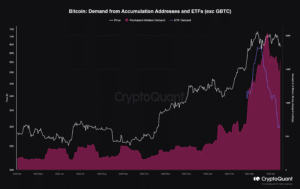Since Friday, BTC has undergone a dramatic 13% swing from just under $71,000 to just below $62,000, and is now trading around $63,700, data from CoinGecko shows. According to a report published on Tuesday from South Korean-based blockchain analytics firm CryptoQuant, the drop was not caused by a single, isolated incident but by concurrent events from different actors.
Here are the two main reasons for BTC’s recent fall, according to CryptoQuant:
1. Bitcoin perpetual traders took profits.
Traders in the perpetual futures market booked profits amid rising conflict and tensions in the Middle East as Iran attacked Israel over the weekend. CryptoQuant pointed to the decrease in BTC’s open interest, which refers to the total number of active long and short positions currently held by investors on derivative exchanges, as evidence of this move.

Total open interest stood around 252,000 bitcoins on April 12 and slid 12.5% to as low as 220,500 bitcoins the next day, before settling around 224,000 bitcoins at presstime, “implying that traders closed their long Bitcoin positions to take profits,” the report stated.
Read More: Bitcoin’s Fourth Halving Is Right Around the Corner. Is It Still a Good Time to Buy?
Not only did the volume of sell orders in perpetual futures markets dominate buy orders, but the funding rates on derivative exchanges also turned negative for the first time since Jan. 2024, per CryptoQuant. While a positive funding rate is a sign that traders are willing to pay to maintain long positions, a negative funding rate implies traders’ commitment to open short positions, bets for a lower BTC price.
2. BTC demand among the largest holders has slowed.
The intention to acquire bitcoin by addresses for spot BTC exchange-traded funds, wallets that hold between 1,000 and 10,000 bitcoins, and permanent holders has also slowed considerably.
For addresses holding between 1,000 and 10,000 BTC, otherwise known as “whales,” the month-over-month growth of their BTC balance has slowed from a record-high of 11% in mid-March to under 8% at press time.

Similarly, accumulating addresses, which only accumulate and don’t spend, and ETF wallets have also “slowed down significantly” their pace of acquiring BTC. For instance, accumulating addresses currently have an acquisition pace of 161,000 bitcoins every month, a 21% drop from roughly 204,000 bitcoins a month during the middle of March.
Read More: How Much Money Could Pour into Hong Kong’s New Bitcoin, Ether ETFs?
The recent sell-off – while a sign that the market was overheated – has placed traders’ unrealized profits at zero, which is “typically a bottom in bull markets,” noted CryptoQuant analysts in their report.
“From a long-term cyclical perspective Bitcoin is still in a bull market phase,” they concluded.



